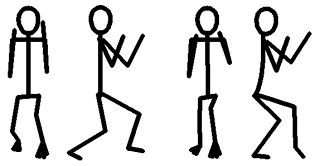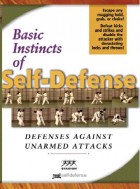Low fighting stances for real fighting? Really?
This tip will deal with low fighting stances — often a neglected and poorly practiced element of fighting and self-defense. Low stances, most often seen in traditional karate and in northern styles of Chinese boxing, are very helpful in self-defense but only if understood and practiced well.
Many top full-contact karate and judo fighters use very low stances. The rule is: The closer the distance the more beneficial is a low stance. Look at the contest performances of technical fighters in those sports and you will notice this.
Low stances are functional but they are not for standing still. They are for moving and protecting from attack and counterattack as you move, whether stand-up fighting or ground fighting. In this issue you will learn the simplest low stance — moro-ashi dachi (parallel foot stance).
Keep your trunk upright and straight, hips low, supported by flexed legs. Most of your weight is on the front of your feet, both feet pointing in the same direction, one foot advanced about one foot-length ahead of the other.
Learn to move in this position and eventually to strike and kick from it or grapple. In grappling this position makes it difficult for your opponent to “shoot” or do a leg takedown on you. For your attacker’s leg grab to work, you see, he needs you to lean forward (or lose balance in any direction). Moro-ashi dachi keeps your trunk straight while keeping hips low on flexed legs, and this lets you intercept your attacker’s dive for your legs.
In karate-type sparring this position lets you absorb shin kicks to the outside of your legs. Bringing the lead knee to the center, shifting your weight to the back foot, and moving your hips to the back naturally flows you into a cat stance (neko-ashi dachi) which protects you from strikes to the groin and inner thighs.
This tip is based on the video Basic Instincts of Self-Defense. Get this video now and have all of the info—not just the crumbs! Order Now!
Self-defense tip from Thomas Kurz, co-author of Basic Instincts of Self-Defense and author of Science of Sports Training, Stretching Scientifically, and Flexibility Express.
Self-Defense Moves
For your defense moves to work under stress they must be based on your natural, instinctive reactions, require little strength and limited range of motion, and be proven in fighting experience.To learn how your natural reactions can instantly defeat any unarmed attack, see the video Basic Instincts of Self-Defense.
Defend Against Weapons
To defend against weapons you have to know how they are used. Also — every stick has two ends … the weapon of attack may become a weapon of defense in your hand …To learn how the typical street weapons (club, knife, razor) are used by an experienced streetfighter and how to practice with them, see the video Self-Defense: Tools of Attack — Club, Hatchet, Blackjack, Knife, Straight Razor.
Mental Toughness
Staying cool under pressure is more important for self-defense than being physically fit and technically skilled. If you can’t control your mind what can you control?To learn mental techniques that let you calmly face any threat and act rationally in the heat of a fight, click here.
For a complete list of our products, click here.








